

Teaching, Tech and Twitter: Starting Our STEM Lab & Making Our Makerspace: Tips, Tricks, Resources & Ideas We Learned About Along the Way. Untitled. Surprise—It’s STEM for Toddlers! Twins stacking cups at the North Bellmore (NY) Public Library with ReneeMcGrath, manager of youth services for the Nassau (NY) Library System.Photo by Michele Rudzewick.
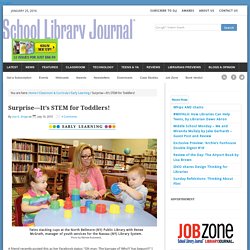
A friend recently posted this as her Facebook status: “Oh man. The barrage of ‘Why?!’ Has begun!!!” I chuckled, and then discovered this statistic in a Boston Globe editorial by J.D. Chesloff, a member of the Massachusetts Governor’s STEM Advisory Council’s Executive Committee: “Young children are inquisitive learners who ask an average of 76 questions per hour.” These nonstop queries are doing important stuff for a developing brain. Research confirms that the brain is particularly receptive to learning math and logic between the ages of one and four. Simple things parents can do at home to encourage math • Put measuring cups and spoons in the bathtub for play. • Use a growth chart or scale to measure a child’s height/weight. • Let a toddler put money in a piggy bank (good for fine motor skills, too). Kids' Bibliotheque: STEM for Preschoolers. A few weeks ago (has it really been that long?)
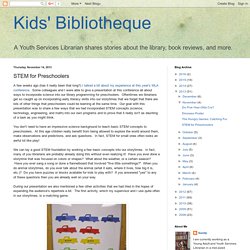
I talked a bit about my experience at this year's WLA conference. Some colleagues and I were able to give a presentation at this conference all about ways to incorporate science into our library programming for preschoolers. Oftentimes we librarians get so caught up on incorporating early literacy skills into our storytimes that we forget that there are lots of other things that preschoolers could be learning at the same time. Our goal with this presentation was to share a few ways that we had incorporated STEM concepts (science, technology, engineering, and math) into our own programs and to prove that it really isn't as daunting of a task as you might think.
You don't need to have an impressive science background to teach basic STEM concepts to preschoolers. We can lay a good STEM foundation by working a few basic concepts into our storytimes. The idea is actually pretty simple. Another fun thing to try is using a parachute: Finding Real-World Problems for STEM Lessons. A MiddleWeb Blog What do STEM teachers do?
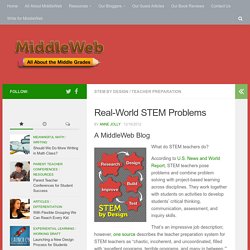
According to U.S. News and World Report, STEM teachers pose problems and combine problem solving with project-based learning across disciplines. They work together with students on activities to develop students’ critical thinking, communication, assessment, and inquiry skills. That’s an impressive job description; however, one source describes the teacher preparation system for STEM teachers as “chaotic, incoherent, and uncoordinated, filled with ‘excellent programs, terrible programs, and many in between.’” What Good STEM Lessons Do While things seem a bit muddled on the STEM teacher preparation front, we do know some things about STEM curriculum. Problem solving is really the heart of STEM investigations.
Providing students with real-world problems and asking them to brainstorm solutions will bring their higher order thinking skills into play. They have to be problems that students can reasonably grapple with. 40 STEM Activities for Kids. Activities for ages 4 and up.
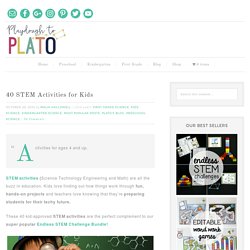
STEM activities (Science Technology Engineering and Math) are all the buzz in education. Kids love finding out how things work through fun, hands-on projects and teachers love knowing that they’re preparing students for their techy future. These 40 kid-approved STEM activities are the perfect complement to our super popular Endless STEM Challenge Bundle! Science Projects We love science so it’s hard to pick a favorite in this first category of STEM activities. Make exploding pop rockets. Pull together an easy water drop race. // What We Do All Day Create fireworks in a jar. // I Can Teach My Child Blow up a batch of magic balloons.
Create a water cycle in a bag. Make ordinary flowers glow in the dark. // Fun at Home with Kids Whip up some magic dancing raisins. // Coffee Cups and Crayons And speaking of dancing, make gummy worms boogy. Test out a simple recipe for Oobleck. // STEM Mom Turn your name into crystals. Whip up a batch of Magic Aqua Sand. // Paging Fun Mums. Full STEAM Ahead: Injecting Art and Creativity into STEM. Illustration by Andy Ward By Amy Koester “I get it!
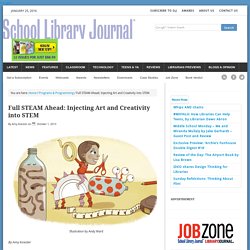
The Titanic sank because too much water got inside! A boat can only hold so much water!” That was the moment it all clicked—the “eureka” moment, if you will—at my library’s “Sink or Float: Titanic Edition” school-age STEAM program. What’s “STEAM?” While government agencies and schools were busy promoting STEM, some educators believed that something was missing. Does STEAM really belong in a library? STEAM has great potential for school and public libraries because it taps into children’s natural interests while also facilitating informal learning. In a public library, STEAM means creating opportunities for children to explore and experiment. Top 10 Go-to Resources for STEAM Programming Books. Inquiry, PBL, Makerspaces on Pinterest. The Ultimate STEM Guide for Kids: 239 Cool Sites. The 10 Best STEM Resources. By Phil Nast, retired middle school teacher and freelance writer Found In: mathematics, science, preK-2, 3-5, 6-8, 9-12 Curriculum Resources Exploratorium Provides interactives, web features, activities, programs, and events for K-12.
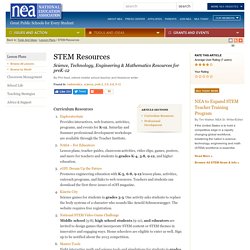
Saturday and Summer professional development workshops are available through the Teacher Institute. NASA – For Educators Lesson plans, teacher guides, classroom activities, video clips, games, posters, and more for teachers and students in grades K-4, 5-8, 9-12, and higher education. Professional Development. 1 stem design logo1.